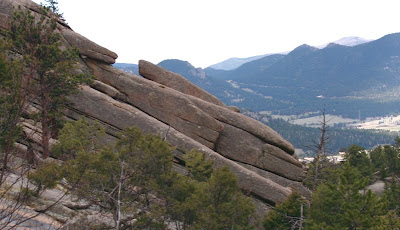Elevation: 5,300 ft to 7,600 ft
Elevation Gain: 2,300 ft
Greyrock is a great early season training hike. It has distance, rock scrambling, and stupendous views. The downside for Denverites, is that it is up Poudre Canyon from Fort Collins, and therefore not as accessible as other trails.
On this trip, we were treated to poison-ivy, pouring rain, and fog. Only the first item is typical this time of year. The mists and pervasive damp transported us at times from Colorado to the Scottish Highlands. On one lofty ridge, we gazed down on the clouds and distant verdant valleys. It took me three days to warm up, and I own a hot tub!
The highlight of the Greyrock Trail is Greyrock Mountain, a towering edifice of stone, whose shear sides would seem impossible to scale. There is a trail that ascends it however, and at the top the hiker is rewarded not only with lofty perches, but also with a hidden pond filled with croaking toads. Between the wind in the Aspens surrounding the pond, the drum of rain on the rocks, and the cacophony of the amphibians, my auditory senses were overwhelmed. Who says the woods are silent. Nature is loud!
Greyrock Mountain itself is a batholith of granite. A batholith is an intrusion magma through a layer of metamorphic rock, sort of like a hernia. This one formed 1.4 billion years ago. Granite is resistant to erosion and so the Greyrock Mountain has remained intact while the surrounding substrate has drifted away.
There are two trails that head towards Greyrock Mountain. They start out together, diverge at 0.64 miles, and reconvene 0.75 miles from the summit. The rightmost trail (Summit) follows a lush riparian gulch for 50% of its length before ascending up a ridge with carelessly strewn granite boulders. The leftmost trail (Meadow) starts out near a stream but quickly ascends up a series of nearly treeless switchbacks to a lofty ridge. It then descends to a long meadow with dramatic views of the Greyrock Mountain before it climbs up again to the intersection of the Summit Trail. Near the intersection are the stark remains of a forest fire. On this trip, we took the Summit Trail up and the Meadow Trail down, so be aware the photos in this post for the Meadow Trail will be in reverse order to this description.
The common trail up Greyrock Mountain is not for the faint of knee or for one-handed hikers. It ascends quickly right next to the shear face of the mountain and at times weaves dangerously close to breath sucking heights. There are obvious wooden posts to keep you near the trail, but most of it is rock scrambling at a Class II level (difficult walking, often steep with doubtful or slippery footing). Perfect training for the summer 14er season. There were two places on this trail that I would categorize as a Class III scramble (handholds and footholds must be utilized to make upward progress). I was carrying a heavy pack and on one of these, a friend needed to pull me up. Had I been alone, I could have taken off the pack and tossed it upwards and then scrambled up solo.
The top of Greyrock Mountain is very much a surprise. From the trail below it looks very solid and very round but in fact it is a boulder field at the top and very flat in portions. Trees have grown into this area and a pond has formed. This is a very serene spot.
 This is just part of the meadow that gives the Meadow Trail its name. That is Greyrock Mountain to the right.
This is just part of the meadow that gives the Meadow Trail its name. That is Greyrock Mountain to the right.The actual summit of Greyrock is at the opposite end of the edifice from where the trail comes in. Because of the rain and the slick rocks, we decided not to scramble up to the official summit. There did not seem to be any trail markers pointing the way either. This turned out to be a good choice. By the time we descended the two Class III spots it was raining in earnest, and the rocks had become very slick. On a normal Colorado day, this would not be an issue.
Our trip down the Meadow Trail was almost surreal. Once past the pleasant meadow, the trail climbs up a long series of ridges. At the apex of these, we decided we were no longer in Colorado but somewhere in the UK. The rain became much heavier at this point as well, adding to the British ambiance. It seemed like it took forever to descend again to the trailhead but finally we made it. Soaked, hungry, but exhilarated none-the-less.
 The Meadow Trail descends down to the saddle in the middle of this picture and then off to the left and down again. The clouds below were drifting rapidly.
The Meadow Trail descends down to the saddle in the middle of this picture and then off to the left and down again. The clouds below were drifting rapidly.The trail begins and ends at a bridge crossing the Poudre River, which was swollen with rain and snow melt. Everyone along the front range should hike Greyrock at least once. Don't take my experience for typical conditions, however. In summer, I suspect this trail would be toasty. Spring and Fall seem like optimal times. For hikers in Ft. Collins, you have no excuse. This great trail is in your back yard.





























































